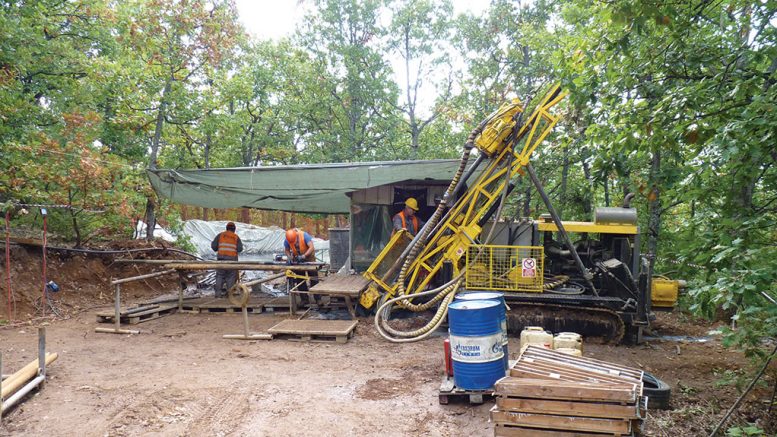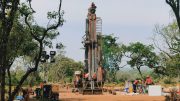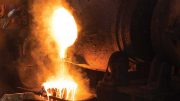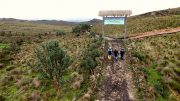Aspiring precious metals developer Velocity Minerals (TSXV: VLC) recently tabled engineering study results and the latest drill assays from its 70%-owned Rozino gold deposit in southeastern Bulgaria.
Rozino, the most advanced of Velocity’s four Bulgarian gold projects, is advancing to the prefeasibility study (PFS) level.
A 2018 preliminary economic assessment (PEA) modelled an open-pit operation with a six-year mine life centred on an inferred mineral resource of 573,000 contained oz. gold within 13 million tonnes grading 1.37 grams gold per tonne (using a cut-off grade of 0.6 gram gold per tonne). The study projected a $129-million after-tax net present value (at a 5% discount rate) and a 33% after-tax internal rate of return. All-in sustaining costs were pegged at US$543 per oz. gold and the study forecast steady gold production of 65,000 oz. annually. The PEA sees development capital requirements of $97.3 million for the mine and concentrate production plant.
Results from Velocity’s latest infill and target drilling returned multiple surface and near-surface gold mineralized intervals on the 160 sq. km property package. Several holes — including hole 138 with 25 metres of 1.49 grams gold from 103 metres’ depth — returned significant mineralization below and outside of conceptual pit designs in the PEA study. Based on these results, the company says there could be potential to combine the main and north open pits defined in its 2018 study.

A core-storage building at Velocity Minerals’ Rozino gold project. Credit: Velocity Minerals.
Additionally, multiple engineering studies have been undertaken en route to the company’s planned completion of the Rozino PFS in mid-2020, including geotechnical studies for both pit and infrastructure design, hydrogeology, processing and metallurgy test work, and an updated mineral resource estimate. Velocity is also studying potential haul road routes and electrical transmission supply and routing.
Velocity describes its planned production strategy as a “hub and spoke” model, envisioning staged open-pit mining of satellite deposits with centralized processing at the nearby carbon-in-leach (CIL) plant operated by its Bulgarian partner Gorubso-Kardzhali. It is the only permitted CIL plant in the country. Velocity entered an exploration and mining alliance with the privately owned Gorubso in early 2018. The alliance encompasses the CIL plant and all existing and future Gorubso and Velocity projects in a 10,400 sq. km area of the Eastern Rhodope gold mining district.
“The most important and valuable aspect of the Gorubso partnership, from our perspective, is that they have an operating CIL plant,” Velocity’s president and CEO Keith Henderson said in an interview. “Permitting CIL plants in Europe these days, or anywhere in the world, is not particularly easy. Permitting these kinds of projects when you’re a small junior company can be extremely challenging and take a very long time, so having that partner and having access to a plant that has been operating for 10 years is a huge advantage for us.
“The partnership also gives us access to a pipeline of projects and we’re systematically earning a 70% interest in all these projects, and each of them could be a satellite that could ultimately be capable of feeding mineralization into the CIL plant,” Henderson continued.
Rozino, which is 30% held by Gorubso, is 85 km southeast of the CIL plant and situated along road transport corridors. The deposit is also 20 km east of Dundee Precious Metals’ (TSX: DPM) recently commissioned, 2,500-tonne-per-day Ada Tepe gold mine.
Velocity’s other joint-venture projects in the area include Obichnik, Makedontsi and Sedefche, and are all located between 10 and 35 km south of the CIL plant. The company is earning a 70% interest in these projects from Gorubso and has undertaken advanced drill programs aiming to deliver initial resource estimates over the next year.
After a recent analyst site visit to Velocity’s projects, Beacon Securities mining analyst Michael Curran is upbeat about the project. “We expect the next [Rozino] resource update will successfully convert the majority of existing inferred resources to indicated, and maintain our view that resources could ultimately be plus-1 million ounces. Additional PFS work should see improvements to gold recoveries and changes to the processing plans [semi-autogenous grinding vs. ball mill, adding a gravity circuit, etc.] could also yield improvements to overall project economics.”
Earlier this year, Velocity attracted the attention of Canadian gold miner Atlantic Gold, which was operating its Moose River Consolidated mine complex in Nova Scotia. Atlantic Gold developed a centralized processing plant plan at Moose River and was mining its Touquoy open-pit operation, with three other deposits and projects in a planned production pipeline.
“Velocity’s strategy is similar to what Atlantic Gold did and led to a situation where they wanted to invest in our company,” Henderson said. “Atlantic, having got to the stage where they were generating significant revenue, were looking very hard around the world for opportunities and ultimately decided Velocity was a project they wanted to invest in. They gave us $9 million in March of this year that we have been deploying into exploration programs on our four projects.”

Studying geological maps at Velocity Minerals’ 70%-owned Rozino gold deposit in southeastern Bulgaria. Credit: Velocity Minerals.
Subsequent to Atlantic’s investment in Velocity, the Nova Scotia gold producer was acquired by Australia’s St Barbara (ASX: SBM) in a deal valued at $802 million. Atlantic’s investment in Velocity was placed in a subsidiary company, Artemis Gold (TSXV: ARTG), which was distributed to Atlantic shareholders upon the closure of its takeover. Artemis holds a 19% interest in Velocity.
Although not a well-known mining jurisdiction, Bulgaria is the third-largest copper producer and fourth-largest gold producer in Europe, and its mineral industry constitutes 5% of the country’s gross domestic product. It has been a member of the European Union since 2007. The main western mining company active in the country is Dundee Precious Metals (TSX: DPM), which operates its Chelopech gold-copper mine and the Ada Tepe gold mine.
As of Sept. 30, Velocity had $5.3 million in its treasury and a $4.8-million working capital position.
Shares in the company closed at 44¢ at press time, in the upper range of its 52-week 56¢ to 16¢ trading range, giving it a $43-million market capitalization.






Wow, if this would be a huge success..it would really be great!